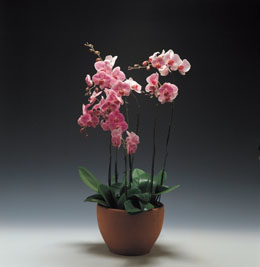Are you an orchid lover or are you thinking about trying orchids for a change. Here are some tips to help you grow some of these gorgeous flowers!

Orchids are very special flowers. Their special qualities are not only due to their lifestyle, but also to what they inspire to people. They have forever symbolized certain qualities and where even worshiped by people. Today, they adorn thousands of homes and represent a genuine passion for a great deal of people. If in the beginning it was impossible to reproduce them outside the habitat of tropical forests, and for this reason they were accessible only to very rich people, today there are orchid cultures practiced today on an industrial level as a result of artificial reproduction.
In their growth, one should mind a few things in order to benefit entirely from their beauty. Thus, during the active vegetation period, orchids must be fertilized twice a week in order to ensure them an optimum growth.
Fertilizers apply to orchids only if the corresponding light is ensured, as well as heat and water at the level required by the species. When flowers start blooming for the plant, it is better to decrease the level of azoth as compared to phosphorus and potassium, because when exceeding, it can inhibit the process of flower formation. When in bloom, the orchid must dispose of higher quantities of potassium.
The transplantation, which is done at an interval of 2-4 years, is determined by the degradation of the substrate as a result of the watering to which it is submitted and which favors it's being made flat. In this case, its roots have no air and cannot breathe. When drainage does not work either, the humidity thus created favors the death of the roots by rotting and asphyxiation. Transplantation must never be applied, except for the emergency cases, during the so-called vegetative stage of the plant's growth. There is an optimum moment for each species which can be either spring or autumn, at most of them. Customary plastic or ceramic pots can be used for this process of transplantation and the chosen pot must not be too big.
Taking the plant out of the pot in order to transplant it must be the least painful for the plant, if the roots got stuck to the walls of the pot or if they are too long and can break easily.
The plant must be cleaned from dead roots, dried leaves and stalks, or from ill parts. After that, all the cuts done can be either burnt or powdered with vegetable charcoal. After its transplantation, for about 2-3 weeks, they do not get watered. The water can be ensured by using a previously-moistened substrate and also by an environment rich in humidity. This can be done by spraying the plant and the surface ground with water every morning.
In certain orchids, one can notice the phenomenon of blackening of the growth tips of the young leaves, which advance to the plant's stalk, and in very grievous cases, it can advance to young pseudo bulbs. This latter case implies a calcium deficiency which can be manifested especially during the hot season when the plant is in full growth, and this can be solved by giving it calcium.
When deep yellow spots that later on become black appear on the leaves, it is a sign of too cold nights or of cold water used for watering. This may occur especially in winter. When their leaves turn red, this means they have excessive light or they didn't get enough azoth fertilization.
The yellowing, necrosis and falling of the flower buttons can be a consequence of excessive heat or of intoxication with the ethylene emitted by the surrounding plants which have lost their freshness. Wrinkles on pseudo bulbs can be a sign of insufficient water or of the necrosis on the roots' surface.
Viruses can get manifested under the form of irregular spots or stripes, yellow at first, then evolving towards necrosis; in order to prevent viruses, the recommendation would be to destroy all insects which are the vectors of the disease and sterilizing the tools that are being used with a natural solution of trisodium phosphate or lime water with a very high Ph level.
Black rots are largely spread. These symptoms may appear at the plant's base or on the roots, the attacked parts turning black, and often presenting with a yellow margin; cutting out the attacked parts and treating them with fungicides are absolutely necessary in this special case.
These are but a few tips on taking good care of this extraordinary plant. The best part about it, is that it usually blooms when least expected, giving great joy to any flower grower!






 Orchids are very special flowers. Their special qualities are not only due to their lifestyle, but also to what they inspire to people. They have forever symbolized certain qualities and where even worshiped by people. Today, they adorn thousands of homes and represent a genuine passion for a great deal of people. If in the beginning it was impossible to reproduce them outside the habitat of tropical forests, and for this reason they were accessible only to very rich people, today there are orchid cultures practiced today on an industrial level as a result of artificial reproduction.
Orchids are very special flowers. Their special qualities are not only due to their lifestyle, but also to what they inspire to people. They have forever symbolized certain qualities and where even worshiped by people. Today, they adorn thousands of homes and represent a genuine passion for a great deal of people. If in the beginning it was impossible to reproduce them outside the habitat of tropical forests, and for this reason they were accessible only to very rich people, today there are orchid cultures practiced today on an industrial level as a result of artificial reproduction.